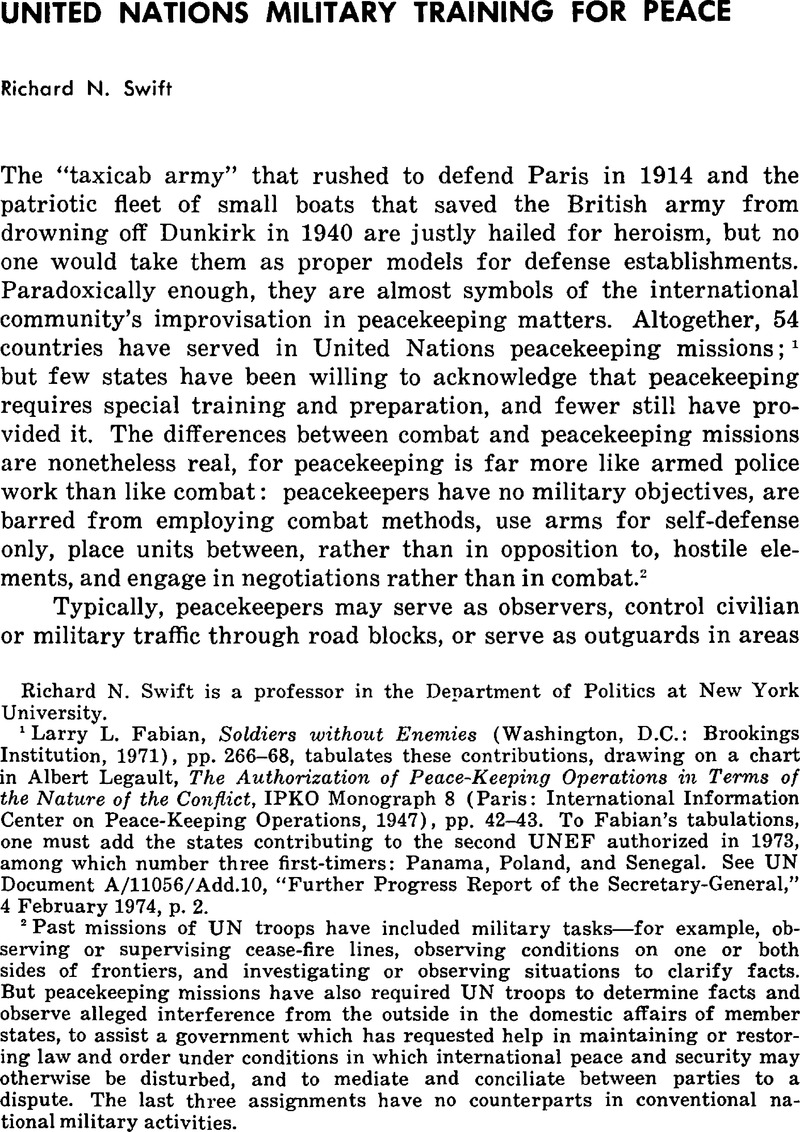Published online by Cambridge University Press: 22 May 2009

1 Fabian, Larry L., Soldiers without Enemies (Washington, D.C.: Brookings Institution, 1971), pp. 266–68Google Scholar, tabulates these contributions, drawing on a chart in Legault, Albert, The Authorization of Peace-Keeping Operations in Terms of the Nature of the Conflict, IPKO Monograph 8 (Paris: International Information Center on Peace-Keeping Operations, 1947), pp. 42–43.Google Scholar To Fabian's tabulations, one must add the states contributing to the second UNEF authorized in 1973, among which number three first-timers: Panama, Poland, and Senegal. See UN Document A/11056/Add.10, “Further Progress Report of the Secretary-General,” 4 February 1974, p. 2.
2 Past missions of UN troops have included military tasks—for example, observing or supervising cease-fire lines, observing conditions on one or both sides of frontiers, and investigating or observing situations to clarify facts. But peacekeeping missions have also required UN troops to determine facts and observe alleged interference from the outside in the domestic affairs of member states, to assist a government which has requested help in maintaining or restoring law and order under conditions in which international peace and security may otherwise be disturbed, and to mediate and conciliate between parties to a dispute. The last three assignments have no counterparts in conventional national military activities.
3 Waern, Jonas, “Diary of a Peacekeeper,” Saturday Review, 18 November 1967, p. 21.Google Scholar Colonel Waern was the Swedish commander of troops on Cyprus and in the Congo.
4 Through the kindness of the Swedish Mission to the United Nations and with the assistance of the Center for International Studies, New York University, I had the privilege of attending the course as an observer in 1970. The material in this comment relating to the course, when not otherwise attributed, is drawn from that experience.
5 Swedish Code of Statutes, No. 18/67, 13 January 1967.
6 References to UNEF are to the 1956–67 period and do not take account of the second UNEF authorized in 1973.
7 Other UN guides available at the United Nations are: Procedures for Radio Communications, Notes for the Guidance of Military Observers on Appointment, and a memorandum on “Administrative Arrangements and General Information for United Nations Personnel Proceeding on Mission Assignment.” These publications are supplemented by two-to-five-day briefings in New York and in the field.
8 If one party requests an inquiry, it is called one-sided; if both parties request it, two-sided.
9 The differences are important according to military officials in UN service, but Fabian's observations (p. 28) are also apposite: “For the soldier-turned-peacekeeper, the contrasts are vivid, although the problems of adjusting to them are frequently overrated by those who hold too stereotyped a view of the military profession, who see its members as devoted to combat and driven by heroic fantasies.”
10 Waern, p. 20.
11 Waern, p. 21.